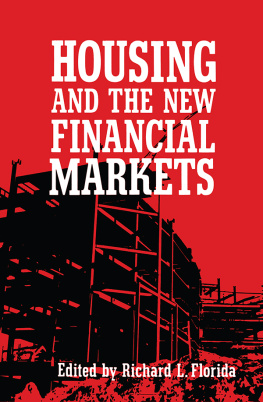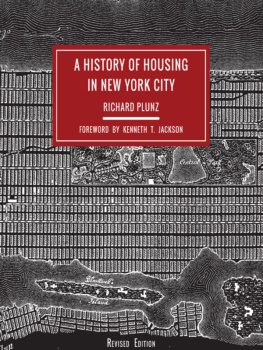Housing and the New Financial Markets
Housing and the New Financial Markets
Edited by
Richard L. Florida
First published 1986 by the Center for Urban Policy Research
Published 2018 by Routledge
2 Park Square, Milton Park, Abingdon, Oxon 0X14 4RN
52 Vanderbilt Avenue, New York, NY 10017
Routledge is an imprint of the Taylor & Francis Group, an informa business
Copyright 1986, RutgersThe State University of New Jersey
All rights reserved. No part of this book may be reprinted or reproduced or utilised in any form or by any electronic, mechanical, or other means, now known or hereafter invented, including photocopying and recording, or in any information storage or retrieval system, without permission in writing from the publishers.
Notice:
Product or corporate names may be trademarks or registered trademarks, and are used only for identification and explanation without intent to infringe.
Library of Congress Cataloging-in-Publication Data
Main entry under title:
Housing and the new financial markets.
Bibliography: p. 469
Includes index.
1. Mortgage loansUnited States. 2. Housing
United StatesFinance. 3. Housing policyUnited
States. I. Florida, Richard L.
HG2040.5.U5H681986332.722097385-22346
ISBN 0-88285-113-6
ISBN 13: 978-0-88285-113-6 (pbk)
CONTENTS
Richard L. Florida
Part I
The New Deal System of Housing Finance
Barbara Miles
Milton P. Semer, Julian H. Zimmerman, John M. Frantz, and Ashley Foard
Daniel F. Williams
Part II
Early Deregulation Initiatives
Richard L. Florida
Almarin Phillips and Donald P. Jacobs
Donald D. Hester
Kent W. Colton
Part III
The New Financial Regulation
Andrew S. Carron
Thomas P. Vartanian
Part IV
Housing Finance Under Reagan
David F. Seiders
Leo Grebler
Part V
The Reorganization of the Thrift Industry
Andrew S. Carron
Jack Harris
Donald R. Fraser
Edward J. Kane
Part VI
The Secondary Mortgage Market
Kevin E. Villani
Charles M. Sivesind
David F. Seiders
Part VII
Alternative Mortgage Instruments
George G. Kaufman and Eleanor Erdevig
Gene D. Sullivan and R. Mark Rogers
Stanley L. Iezman
George Kaufman and Jon Paulsen
George E. Peterson and Thomas Muller
Part VIII
The Future of Housing Finance
Patric H. Hendershott and Kevin E. Villani
James W. Christian and Michael L. Wilson
George Sternlieb and James W. Hughes
I express my thanks to the authors and publishers for their permission to reprint the articles presented in this volume.
My sincere appreciation goes to Mary Picarella for guiding this book through publication and Arlene Pashman for her invaluable assistance in bringing this book to fruition. I am especially grateful to George Sternlieb and my former colleagues at the Center for Urban Policy ResearchRobert W. Burchell, Robert Lake and David Listokinwho have been a constant source of encouragement in this and related efforts.
Richard L. Florida
Introduction
The past few years have witnessed a virtual revolution in the way this nation finances housing. Gone is the insulated system of thrifts whose special job was to collect savings deposits and issue mortgages. Gone too are the institutional foundations of this systemthe passbook account and the fixed rate mortgage. Residential finance has been transformed from a relatively sheltered to a completely deregulated system. Mortgage lending in this new financial environment is increasingly the province of a shrinking group of large financial firms. These firms compete for funds in domestic and international markets as well as issue and sell the new adjustable-rate mortgages, like securities, on the secondary mortgage market. In the very near future, there will be few, if any, distinct housing finance institutions.
Emerging Issues
It is not surprising then that the reorganization of the housing finance system has become the focus of a burgeoning policy debate and a growing academic literature. A host of questions have been raised. What are the driving forces behind the financial deregulation? How does deregulation affect housing finance? What are the new institutions and instruments IX being used to allocate housing credit and how do they work? How does the new housing finance system influence the cost and affordability of shelter? What is the future of housing finance?
These are the core questions addressed in the following pages. Reflective of these issues, the readings presented herein have been grouped as follows:
The New Deal System of Housing Finance
Early Deregulation Initiatives
The New Financial Regulation
Housing Finance Under Reagan
The Reorganization of the Thrift Industry
The Secondary Mortgage Market
Alternative Mortgage Instruments
The Future of Housing Finance
Before proceeding to the readings, however, a brief historical review is presented.
An Historical Overview
The New Deal System of Housing Finance
The old housing finance system was part and parcel of the financial structure established under the regulatory framework of the New Deal. The far-reaching New Deal financial reforms, including the Glass-Steagall Act, the Securities and Exchange Act, the Banking Act of 1935 and the Federal Home Loan Bank Act, basically functioned in tandem to erect regulatory barriers between the various segments of the financial industry and to bring the different types of institutions under the umbrella of specific regulatory bodies. These institutions were not allowed to offer checking accounts; their activities, like those of commercial banks, were limited to one state. Thrifts were legally required to invest in housing and were granted generous tax advantages in order to do so.
As a consequence, the thrift industry became virtually synonymous with housing finance. Savings deposits were clearly distinguished from more volatile flows of funds in national capital markets. The basic function of this insulated housing finance system was to accumulate capital from these deposits and to plow that capital back into the economy as housing credit. The advent of government mortgage insurance under the Federal Housing Administration (FHA) and Veterans Administration (VA) brought the next major component to the systemthe low-down payment, long-term, fixed-rate, self-amortizing loan. This became the basic vehicle for channeling housing credit to consumers. Later a limited secondary market, where mortgages could be bought and sold, was set up under the Federal National Mortgage Association (FNMA) to offer some liquidity. Simply put, small thrifts operating in local markets issued mortgages and collected payments as portfolio lenders; new loans were made from repayments and new deposits. presents the basic contours of the New Deal system.











